Why are cats afraid of water?
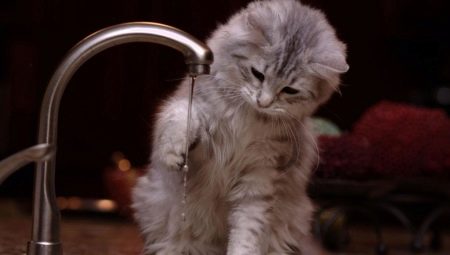
Each owner at some point begins to think about how to redeem his cat. But this procedure is not the most pleasant for the animal - cats categorically refuse to swim. This is manifested in aggressive behavior: the cat begins to scratch its owner with bulging eyes and tries in every possible way to get out of the water. The secret of why cats are so afraid of water has been revealed over time, and in this article you will learn about it.

Why are cats afraid of water?
All actions of animals are associated with the instincts of safety, survival and food, especially when it comes to predators. The fear of water can be explained by just these postulates. Wet hair for a cat is a threat to life, because the coat gets wet, therefore, it loses heat, and the skin of the animal freezes.
Animals have great fear of hypothermia. Even if a caring owner wraps his beloved furry in a blanket after bathing, this will not save the situation. The cat will shiver not only from the cold, but also from the fear of being overcooled. And in this state he will remain until his fur dries up.
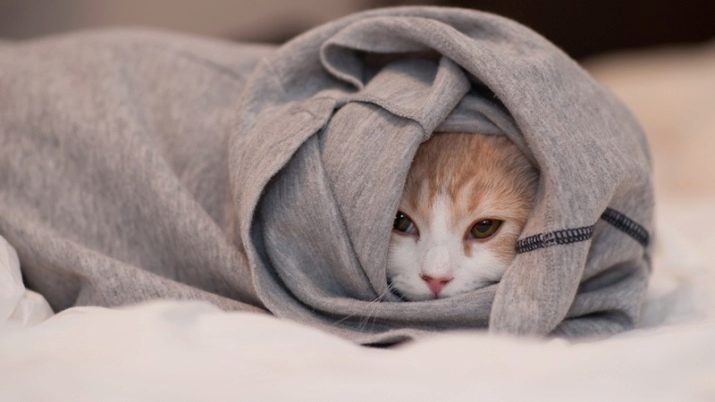
Wool protects the animal from overheating. In summer you can see many cats lying in the sun and in no hurry to leave their favorite places.
What's interesting: even in the hottest weather, cats are in no hurry to cool down - they avoid cool water bodies, subconsciously afraid of losing their ability to keep warm.

But there is one more point that should be pointed out - cats are afraid of becoming infected with pathogens when they are in the water and when they wash. On average, cats wash at least 10 times a day. Street dirt and wet hair are not a good tandem for a cat. In a humid environment, bacteria thrive, and dirt from dry hairs is less dangerous. Moreover, pets regurgitate hairballs from time to time.
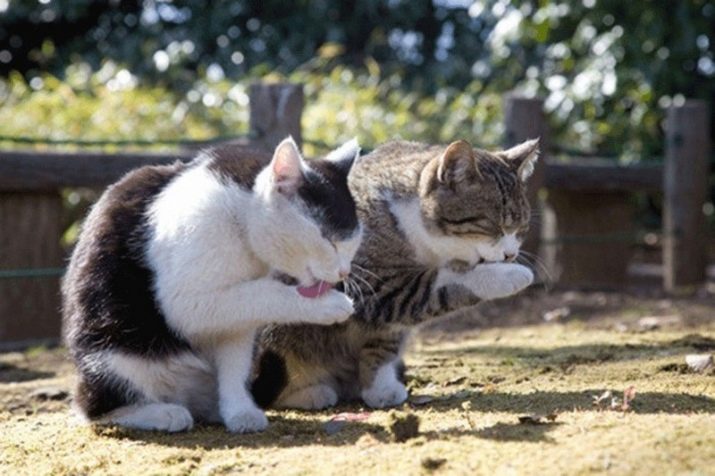
In addition, raw cat fur gives off a specific smell. At a time when the cat will hunt its prey, it will scare it off by the smell, in addition, enemies will calculate the cat from it.
For example, on the outskirts of cities, wild animals that have not eaten for a long time - a lynx, a bear or a wolf - can attack the fluffy ones.

Previously, cats lived in the foothills and thickets along the banks of streams, but when they were domesticated (this happened on the lands of the Fertile Crescent, rich in swamps and lakes), cats have forgotten how to dive into the water. Due to evolution, the small size of the cat and loneliness are not suitable for distant wanderings, but a sedentary lifestyle suits them.
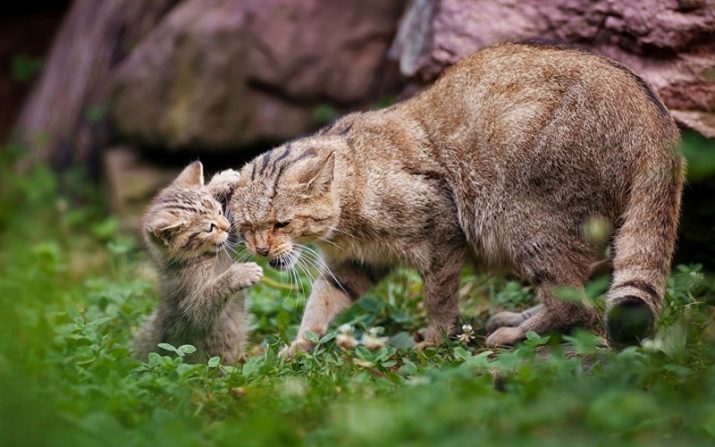
As zoologists say, the main reason cats are afraid of water is primarily evolutionary. Cats do not need to go into the water once again, because chasing prey now there is no such need as before. The mustachioed fluffy is now waiting for food at the store, in the yard or in the apartment of its owners, who will happily share a tasty piece with him. Cats are not afraid of water itself, but of what it carries for them. They all know how to swim since 2 weeks, but they do it in extreme cases.
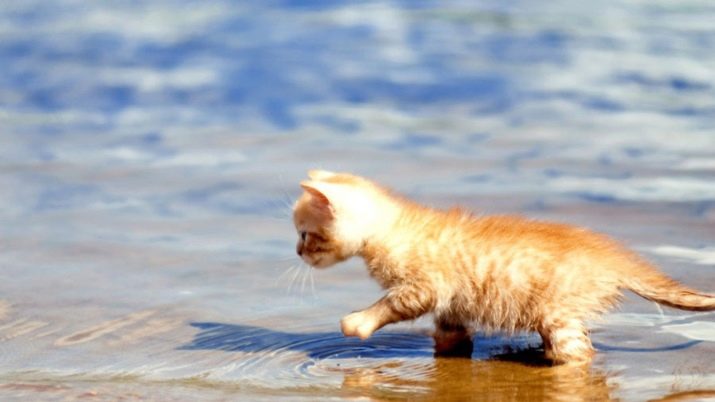
How to train your cat to water?
The most basic mistake of all owners of their cats is that they put the animal in a bath or a basin of water without first having accustomed it. The cat should be gradually prepared for bathing, first turn on the tap - let him touch the water with his paw, play with it. Almost all cats will love playing with water - they all love to frolic and it is more correct to teach a pet to it after a few weeks from birth. How to train a cat to water?
- Turn on the tap periodically, let the cat examine the water and begin to understand that it will not harm him.
- The next step is to let the cat jump into the bathroom or sink. You will be surprised, but the cat can drink water from under the trickle.
- When the cat is comfortable, stay with her and watch how she plays with water, drinks from the tap. It is necessary to ensure that the animal is not embarrassed by your presence.
- When your cat calmly touches the water and drinks it, close the bathtub with a stopper and draw a small amount of warm water. When the cat once again wants to play with water, she will wet her paws and understand that there is nothing wrong with the water, and then she will not be frightened by the recruited bath.
- At first, the cat's reaction to when you bathe will be negative, to minimize this, gradually increase the water in the bath before that. Let her be half bath (fear not, cats can swim!), And once you go into the bathroom and see how your cat became a real swimmer. After that, you can already start swimming.
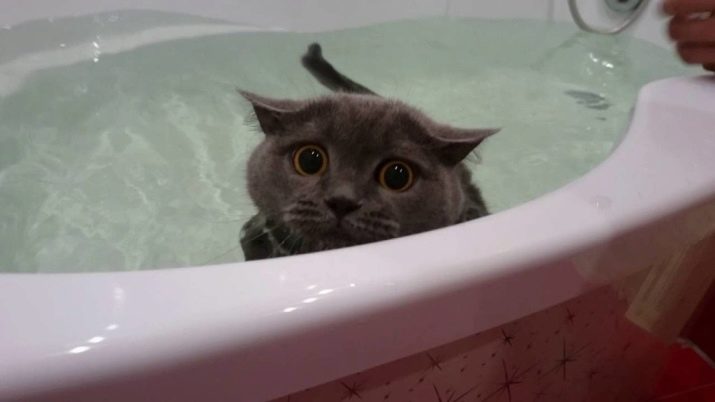
Fears of a cat from bathing at home
Even the most gentle and affectionate cat turns into a wild beast if immersed in water without prior preparation. She will easily use all her weapons: claws, teeth, hissing ... If you learn more about why cats are so afraid when their owners want to redeem them, then the behavior becomes quite justified. Mistakes when bathing a cat.
- Compulsion... Cats are, first of all, freedom-loving animals, they are not dogs that willingly obey their master. Forcing to swim is a mistake. Even a small hint that you want to force your furry to wash, he will be regarded as coercion and the cat will have no choice but to resist you.
- The cat is afraid from where he is - he is used to clinging to his claws, and a slippery bath makes the animal defenseless, so it is strange to be surprised when he rather wants to get out of an unpleasant place for him and bulges his eyes. Its soil is knocked out from under its feet, and the animal wants to be outside the bathroom as soon as possible - after all, the animal perceives a moment as eternity, you cannot tell them, like a child: "Be patient, I will redeem you in just 5 minutes."
- Deafening sound of water cats perceive it as a waterfall or a rapid flow of a river. To fall into a waterfall means to die, and the voice of the ancestors begins to sound the alarm. In this situation, the cat does not just feel fear, everything that happens in the animal causes enormous stress, adrenaline panic.
- With scents people usually protect their belongings from the cat, which relieves in inappropriate places. All cats do not like household chemicals very much, and bathing their fluffy cannot be imagined without shampoo. The stench of chemicals, shampoo disgusts the cat, and his only desire is to get out of unfavorable conditions as soon as possible. A cat's scent is stronger than a human.
- When the owner bathes his cat, then, as a rule, forgets that water can get into his ears, nose and eyes. The animal does not like when its head gets wet, because the main thing for it is to preserve its hearing, scent and sight. In addition, it seems to the animal that in such conditions it will drown.
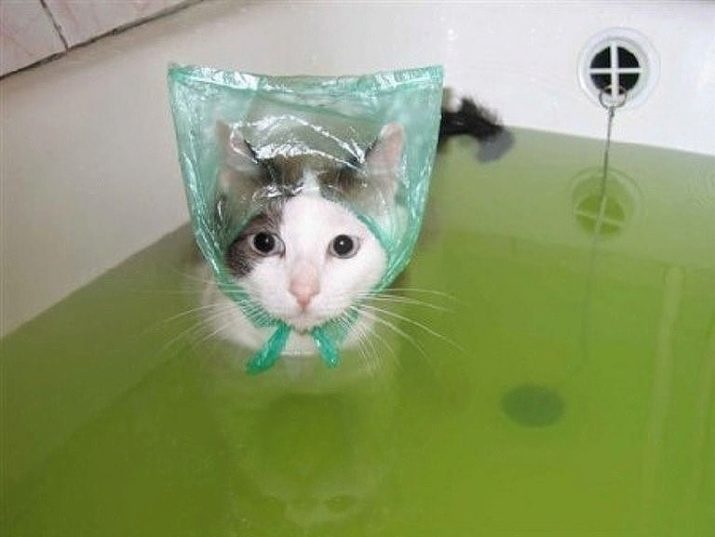
In nature, cats are indifferent to water, but bathing at home can be a real torture for an animal. To make the cat comfortable, all conditions must be observed.
How to bathe properly?
Of course, a cat should be taught to water at a tender age, but if this did not work out, it's okay, an adult animal can also be taught. When the fluffy has got used to it and does not perceive the water as a threat, then you can proceed to the action - bathing. It is better to start with a game - for example, put a ball into a basin, the cat will definitely want to get it with its paw and eventually get used to the water. Step-by-step bathing of a cat looks like this.
- Bath is not suitable for bathing, it is better to use a bowl-shaped device. For effective and comfortable bathing, choose a spray shampoo such as Waterless Cat Shampoo Spray. If you are not quite sure which shampoo to choose, it is not necessary to use it, you can simply lather the cat a little.
- It's easier to bathe your cat with someone's help. It will be better if one person helps you hold the animal and you wash it.
- Moisten the animal's fur and only then can it be washed with water. Do not direct shower water at the cat - it is better to draw water into the palm of your hand and gradually moisturize the animal's fur. After that, you should apply a little shampoo or wash the coat with soap.
- Water should not enter ears and eyes - so that the auricles are safe, it is advisable to cover them with cotton pads. The cat's muzzle should be washed at the very end and without shampoo.
- After bathing, the animal's coat must be thoroughly washed, so that no shampoo remains on the skin, because it can cause itching and burning.
After bathing, wrap the fluffy in a warm blanket to keep it warm.
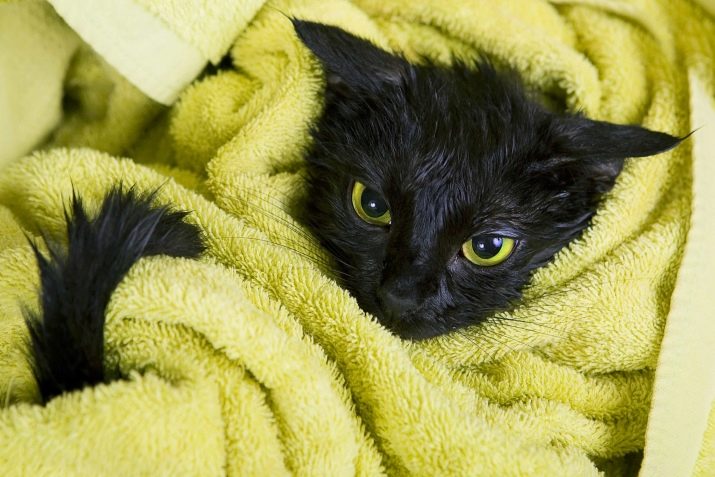
Do not forget that it is contraindicated to bathe your cat frequently, and it is also undesirable to immerse pregnant cats in water.
What breeds are not afraid of water?
There are always exceptions to the rules, this also applies to cats. Some breeds love to swim, sometimes, watching funny videos on the Internet, you can see how some cats sit quietly in a basin of water and take bathing well. What breeds love water:
- Maine Coon;
- Turkish van;
- bengal;
- American bobtail;
- Egyptian Mau;
- Kurilian bobtail;
- Norwegian forest.

These cats are amazing, some of them not only love to swim, but can also catch prey in the water. Cats are not afraid of water, but the danger it poses to them. If you gradually accustom your beloved pet to water, then over time you will be able to gain the trust of the cat, and he will not be afraid to plunge into the water with the help of your caring hands.

For more information on why cats are afraid of water, see the next video.

































And my Siamese is crazy about bathing.
The Siamese endlessly climbs into the water and is not at all afraid of the depths.